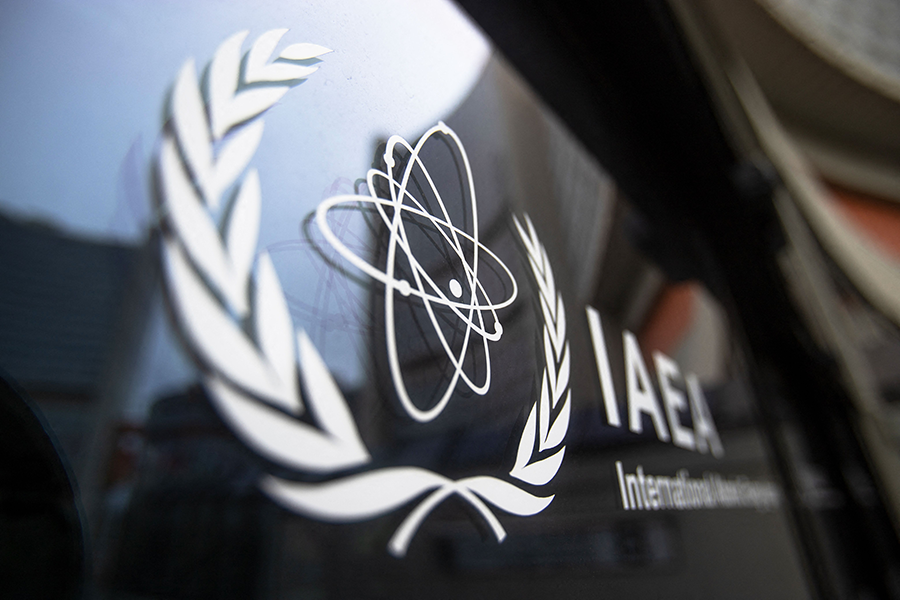Iran’s Nuclear Growth Puts Deal at Risk
December 2021
By Kelsey Davenport
As negotiations to restore the 2015 nuclear deal resumed on Nov. 29 in Vienna, Iran’s uranium-enrichment program continued to grow, deepening concerns that Tehran is not serious about returning to compliance with the accord.
 According to a Nov. 17 report from the International Atomic Energy Agency (IAEA), Iran’s stockpile of uranium enriched to 20 percent uranium-235 is 114 kilograms, up from 85 kilograms documented in the agency’s prior report, issued Sept. 7. The stockpile of uranium enriched to 60 percent U-235 is 17.7 kilograms, up from 10 kilograms.
According to a Nov. 17 report from the International Atomic Energy Agency (IAEA), Iran’s stockpile of uranium enriched to 20 percent uranium-235 is 114 kilograms, up from 85 kilograms documented in the agency’s prior report, issued Sept. 7. The stockpile of uranium enriched to 60 percent U-235 is 17.7 kilograms, up from 10 kilograms.
Uranium enriched to these levels poses a more significant proliferation risk because it can be enriched more quickly to the level of weapons grade, or 90 percent U-235. For that reason, Iran was prohibited from enriching uranium above 3.67 percent U-235, a level suitable for nuclear power reactors, for 15 years under the nuclear deal, known as the Joint Comprehensive Plan of Action (JCPOA). Iran enriched uranium to 20 percent prior to the JCPOA negotiations, but only began enriching to 60 percent in April. (See ACT, May 2021.)
In January 2021, Iran began enriching uranium to 20 percent in accordance with a December 2020 law that was passed by Iran to pressure the United States into lifting sanctions and returning to compliance with the JCPOA. (See ACT, January/February 2021.) The United States reimposed sanctions in May 2018 and withdrew from the deal, despite U.S. intelligence acknowledging that Iran was complying with the accord. (See ACT, June 2018.)
The Nov. 17 report also noted that Iran accelerated its installation of more advanced IR-6 centrifuges, which can enrich uranium more efficiently than the IR-1 machines that were permitted for enrichment under the JCPOA.
According to the IAEA, Iran has installed more than 170 IR-6 machines at its Fordow nuclear facility since the September report. These machines are not yet enriching uranium, but Iran is required to begin operating 1,000 IR-6 centrifuges by the end of the year in accordance with the new Iranian law. The new machines bring Iran to about 400 installed IR-6 centrifuges, of which about 210 are operating.
Iran’s continued manufacture and use of advanced centrifuges and its enrichment of uranium to 60 percent pose a more significant risk to multilateral efforts to restore U.S. and Iranian compliance with the JCPOA because Tehran has gained knowledge from these activities that cannot be reversed.
Biden administration officials have consistently stated that the United States seeks to return to compliance with the JCPOA alongside Iran, but only if the nonproliferation benefits of the deal can be fully restored. They appear to be using the 12-month breakout time established by the JCPOA as the metric for determining if returning to the agreement is still viable. A 12-month breakout means that if Iran were to decide to pursue nuclear weapons development, it would take a year to produce the fissile material for one bomb. Weaponization could take another two years.
Iran’s breakout time now is about one month. Reestablishing the 12-month breakout time frame becomes more challenging over time because of the knowledge Iran has gained from developing nuclear capabilities it did not have prior to the JCPOA, such as operating more efficient centrifuges and enriching uranium to 60 percent.
Iran’s nuclear advances have increased concerns in the region and among parties to the accord that Tehran is not serious about restoring the JCPOA. Talks to restore the deal resumed Nov. 29 after a five-month hiatus.
French Foreign Minister Jean-Yves Le Drian told Le Monde on Nov. 19 that the resumed talks will enable Paris to assess Tehran’s willingness to pick up where discussions left off in June. He warned that if the “discussion is a sham, then we will have to consider the JCPOA empty.”
Israel already appears to believe that Iran no longer intends to return to the JCPOA, despite Iranian President Ebrahim Raisi reiterating that restoring the deal is Iran’s goal.
Israeli Foreign Minister Yair Lapid said on Nov. 15 that Iran is buying time and has no intention of returning to the accord. His comments came after a meeting with Robert Malley, U.S. special envoy for Iran.
The previous week, Aviv Kochavi, chief of staff of the Israel Defense Forces, told the Knesset Foreign Affairs and Defense Committee that the military is "speeding up the operational plans and readiness for dealing with Iran and the nuclear military threat."
Israel has attacked Iranian nuclear facilities in the past and assassinated nuclear scientists to slow the program. Tehran has generally responded by ratcheting up its nuclear activities. For instance, Iran cited an explosion at the Natanz uranium-enrichment facility in April as motivating its decision to enrich to 60 percent.
Similarly, the assassination of Iranian scientist Mohsen Fakrizadeh in November 2020 led to the passage of
the law that mandated the acceleration of certain nuclear activities, including enrichment to 20 percent, and new
breaches of the JCPOA.
In addition to Israeli officials, Malley held talks with officials from the Gulf Cooperation Council, Egypt, and Jordan during a Nov. 18 trip to Saudi Arabia. He was joined by officials from France, Germany, and the United Kingdom, who are participating in the negotiations with Iran.
A U.S. State Department statement on Nov. 18 said that the parties underlined that “a return to mutual compliance with the JCPOA would benefit the entire Middle East.”
